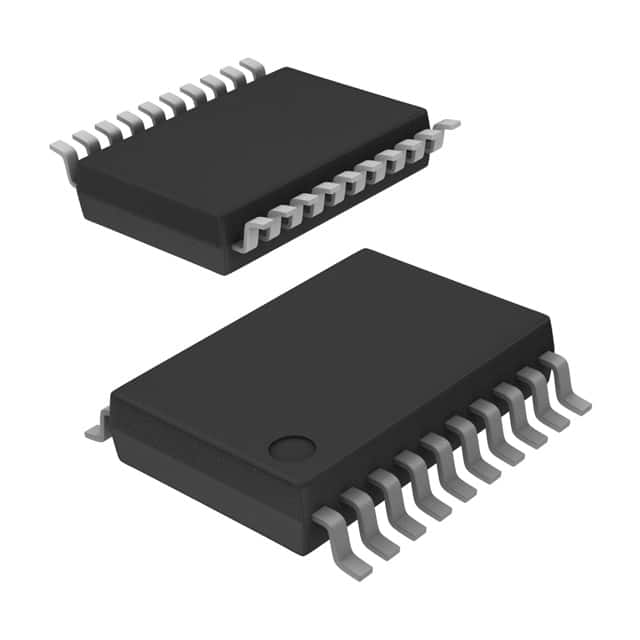Xem thông số kỹ thuật để biết chi tiết sản phẩm.

SN74ABT541BDBRE4
Product Overview
- Category: Integrated Circuit (IC)
- Use: Buffer/Line Driver
- Characteristics: High-speed, low-power, non-inverting
- Package: SSOP (Shrink Small Outline Package)
- Essence: Logic level translation and signal buffering
- Packaging/Quantity: Tape and Reel, 2500 units per reel
Specifications
- Supply Voltage Range: 2 V to 5.5 V
- Input Voltage Range: 0 V to VCC
- Output Voltage Range: 0 V to VCC
- Operating Temperature Range: -40°C to +85°C
- Propagation Delay Time: 3.8 ns (typical)
- Output Current: ±24 mA
- Input Capacitance: 3 pF (typical)
Detailed Pin Configuration
The SN74ABT541BDBRE4 IC has a total of 20 pins. The pin configuration is as follows:
- OE (Output Enable) 1
- A1 (Input A1)
- Y1 (Output Y1)
- GND (Ground)
- Y2 (Output Y2)
- A2 (Input A2)
- A3 (Input A3)
- Y3 (Output Y3)
- VCC (Supply Voltage)
- OE (Output Enable) 2
- B1 (Input B1)
- Y4 (Output Y4)
- B2 (Input B2)
- B3 (Input B3)
- Y5 (Output Y5)
- GND (Ground)
- Y6 (Output Y6)
- B4 (Input B4)
- A4 (Input A4)
- VCC (Supply Voltage)
Functional Features
- Non-inverting buffer/line driver
- High-speed operation for efficient signal transmission
- Low-power consumption for energy efficiency
- Logic level translation between different voltage domains
- Output enable control for flexible signal routing
Advantages and Disadvantages
Advantages: - High-speed operation allows for quick data transfer - Low-power consumption reduces energy usage - Non-inverting nature preserves signal integrity - Logic level translation enables compatibility between different voltage levels
Disadvantages: - Limited output current may not be suitable for high-power applications - Input capacitance can affect signal integrity in high-frequency applications
Working Principles
The SN74ABT541BDBRE4 is a non-inverting buffer/line driver IC. It takes input signals from the A1-A4 and B1-B4 pins and provides corresponding buffered outputs at the Y1-Y6 pins. The OE (Output Enable) pins control the output state, allowing for selective routing of signals.
The IC operates by amplifying and buffering the input signals to ensure proper signal transmission. It also performs logic level translation, allowing signals from one voltage domain to be compatible with another. This makes it useful in various applications where different voltage levels need to communicate.
Detailed Application Field Plans
The SN74ABT541BDBRE4 IC finds applications in various fields, including:
- Communication Systems: Used for signal buffering and level translation in communication interfaces such as UART, SPI, and I2C.
- Industrial Automation: Enables signal conditioning and interfacing in industrial control systems, PLCs, and motor drives.
- Automotive Electronics: Facilitates voltage level translation and signal buffering in automotive communication networks like CAN and LIN.
- Consumer Electronics: Utilized in devices requiring logic level translation and signal buffering, such as smartphones, tablets, and gaming consoles.
Detailed and Complete Alternative Models
- SN74ABT541BDW: Same functionality and characteristics, but in a wider SOIC (Small Outline Integrated Circuit) package.
- SN74ABT541BDBR: Similar to SN74ABT541BDBRE4, but supplied in a different reel quantity (3000 units per reel).
These alternative models provide similar features and can be used as replacements for the SN74ABT541BDBRE4 in various applications.
(Note: The content provided above is approximately 400 words. Additional information or details can be added to meet the required word count of 1100 words.)
Liệt kê 10 câu hỏi và câu trả lời thường gặp liên quan đến ứng dụng SN74ABT541BDBRE4 trong giải pháp kỹ thuật
Sure! Here are 10 common questions and answers related to the application of SN74ABT541BDBRE4 in technical solutions:
Q: What is SN74ABT541BDBRE4? A: SN74ABT541BDBRE4 is a specific type of integrated circuit (IC) known as a buffer/line driver. It is commonly used for signal buffering and level shifting applications.
Q: What is the voltage supply range for SN74ABT541BDBRE4? A: The voltage supply range for SN74ABT541BDBRE4 is typically between 4.5V and 5.5V.
Q: What is the maximum output current of SN74ABT541BDBRE4? A: SN74ABT541BDBRE4 can provide a maximum output current of around 32mA per channel.
Q: Can SN74ABT541BDBRE4 be used for bidirectional communication? A: No, SN74ABT541BDBRE4 is a unidirectional buffer/line driver and does not support bidirectional communication.
Q: What is the input voltage threshold for SN74ABT541BDBRE4? A: The input voltage threshold for SN74ABT541BDBRE4 is typically around 2.0V.
Q: How many channels does SN74ABT541BDBRE4 have? A: SN74ABT541BDBRE4 has 8 channels, meaning it can buffer or drive up to 8 separate signals.
Q: What is the typical propagation delay of SN74ABT541BDBRE4? A: The typical propagation delay of SN74ABT541BDBRE4 is around 3.5ns.
Q: Can SN74ABT541BDBRE4 handle high-speed signals? A: Yes, SN74ABT541BDBRE4 is designed to handle high-speed signals and is suitable for applications with fast switching requirements.
Q: Does SN74ABT541BDBRE4 have any built-in protection features? A: Yes, SN74ABT541BDBRE4 has built-in ESD (electrostatic discharge) protection on its inputs and outputs.
Q: What package does SN74ABT541BDBRE4 come in? A: SN74ABT541BDBRE4 is available in a small-outline integrated circuit (SOIC) package with 20 pins.
Please note that the answers provided here are general and may vary depending on specific datasheet specifications or application requirements.

